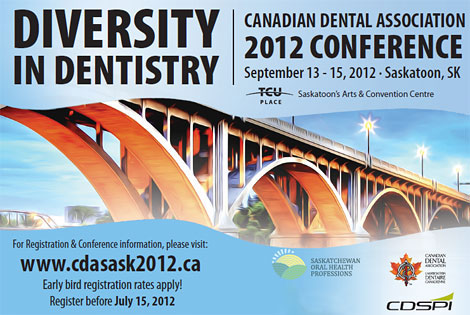Restoring proximal contacts with composite resin restorations

In this edition of JCDA Express, Dr. Dorothy McComb, former head of restorative dentistry at the University of Toronto faculty of dentistry, discusses 4 articles that examine what factors produce optimal contact tightness with composite restorations. Dr. McComb provides some background about the clinical challenges of composites then shows how these 4 articles address common clinical concerns.
|



|
Introduction
- Proximal contacts are important to maintain gingival health and tooth position, prevent food impaction and ensure patient comfort after a new restoration. An “open” proximal contact can lead to gingival irritation, pocketing and increased risk of recurrent caries.
-
Production of ideal proximal contacts is more difficult with resin composite than amalgam largely due to its lack of packability. Many practitioners encounter difficulties in ensuring a firm contact and must pay special attention to effective matricing procedures.
-
Several techniques have been recommended, including heavy wedging, various types of interdental separators, ceramic proximal inserts, and internal use of outward pressure on the matrix by certain instruments during composite insertion.
- In a recent survey1 of clinicians’ posterior composite restorative techniques in the United Kingdom, the majority of dentists used solely traditional circumferential matrices for posterior composites. Almost half of the practitioners (52%) reported that they experienced problems with food packing in more than 1 in 4 posterior composites placed.
Clinical Questions:
What evidence exists from clinical studies on how to best produce effective proximal contacts with composite?
-
Loomans BA, Opdam NJ, Roeters FJ, Bronkhorst EM, Burgersdijk RC, Dörfer CE. A randomized clinical trial on proximal contacts of posterior composites. J Dent.2006;34:292-97.
Full-text access to this article has expired.
JCDA Clinical Pearl: For 2-surface Class II posterior composite resin restorations, a combination of sectional matrices with separation rings achieves stronger proximal contacts than a circumferential matrix system.
This in vivo study found that for 2-surface Class II composite restorations, the use of sectional matrices combined with separation rings resulted in increased contact tightness, as measured by proximal contact strength. The use of a traditional circumferential matrix with an interdental wooden wedge resulted in decreased contact tightness compared to the situation before treatment.
|

|
What about 3-surface Class II restorations?
-
Wirsching E, Loomans BA, Klaiber B, Dörfer CE. Influence of matrix systems on proximal contact tightness of 2- and 3-surface posterior composite restorations in vivo. J Dent. 2011;39:386-90.
Full-text access to this article has expired.
JCDA Clinical Pearl: Contact tightness differences between use of sectional matrices with separators and traditional circumferential matrices with wedges are less pronounced when both proximals of 3-surface mesio-occlusal-distal (MOD) preparations are restored simultaneously. However, the traditional circumferential matrix system with no additional separation techniques is least likely to produce adequate contact tightness in both 2-surface and 3-surface restorations.
The study authors investigated both 2- and 3-surface Class II composite restorations in vivo using the same 2 matrix systems: (1) a sectional matrix system combined with separation rings, and (2) a traditional circumferential matrix with wooden wedges used to achieve separation.
The results for the 2-surface caries are consistent with the Loomans et al. study (see above)—the sectional matrix plus separator produced significantly tighter contacts for 2-surface restorations, whereas use of a circumferential matrix produced significantly weaker contacts compared to the situation before treatment.
For 3-surface restorations, differences in proximal contact tightness were not statistically significant between matrix systems, although a weak increase in tightness was found using a sectional matrix system and a slight decrease was found using a circumferential matrix system. The diminished effect of the 2 separation rings and sectional matrices in 3-surface restorations, as compared to 2-surface, was likely due to opposing pressures from each side of the tooth.The smaller decrease in contact tightness with circumferential matrices in 3-surface restorations, as compared to 2-surface, was likely because the presence of both M and D preparations allows space for matrix band thickness.
The authors concluded that the traditional circumferential matrix system, in which no additional separation techniques were used, failed to produce tight contacts in both 2-and 3-surface restorations.
To avoid the diminished effect of simultaneous use of interdental separators at both M and D, the authors suggested sequential separator usage.
|

|
Will a loose contact close in time?
-
Loomans BA, Opdam NJ, Roeters FJ, Bronkhorst EM, Plasschaert AJ. The long-term effect of a composite resin restoration on proximal contact tightness. J Dent. 2007;35:104-8.
Full-text access to this article has expired.
JCDA Clinical Pearl: Clinicians cannot rely on mesial drift to close loose contacts ofposterior composite restorations. Contacts tighter than the pre-operative situation reduce over time but remain positive. Contacts looser than the pre-operative situation remain loose.
It is commonly thought that mesial drift will close loose proximal contacts over time. This clinical study measured changes in proximal contact tightness up to 6 months following restoration. Patients were allocated to 2 groups—those with proximal contacts that became tighter and those that became looser after Class II composite restorations.
Tighter contacts after treatment tended to loosen after a 6-month period, although they remained significantly tighter than the situation before treatment. The authors attribute this effect to an adaptation mechanism of the periodontal ligament and/or composite wear at the proximal surface.
In contrast, looser contacts after treatment remained almost unchanged after a 6-month period. This study suggests that stable intercuspal relationships can impede mesial drift and that loose contacts are unlikely to become tighter over time.
|

|
Do interdental separators help provide tight contacts when used with traditional circumferential matrices?
-
Saber MH, Loomans BA, El Zohairy A, Dörfer CE, El-Badrawy W. Evaluation of proximal contact tightness of Class II resin composite restorations. Oper Dent. 2010;35(1):37-43.
Full-text access to this article has expired.
JCDA Clinical Pearl: For 2-surface Class II resin composite restorations, a sectional matrix system combined with a separation ring achieves greatest proximal tightness compared to other placement techniques. Use of interdental separators with circumferential matrices rather than wedges can improve contact tightness.
This in vitro study looked at several techniques for restoring 2-surface Class II resin composite restorations on typodonts, in comparison to a sectional matrix system combined with a separation ring (the gold standard). Of all systems tested, a sectional matrix system with separation ring provided the tightest contacts.
A circumferential matrix used with a ring separator or with an Elliot separator was able to provide an intermediate contact tightness that was significantly tighter than the use of a wedge alone but not as tight as use of a sectional matrix with ring separator. There was no significant difference with the internal use of outward pressure on the circumferential matrix by an instrument or ceramic insert over the use of a wedge alone. Such contacts were significantly lower compared to the gold standard.
|

|
Conclusions
- The key factor in the provision of tight proximal contacts with composite is ensuring interdental separation during placement of the restoration.
-
Use of sectional matrix systems in combination with interdental separation rings more reliably results in tighter proximal contacts.
-
Proximal contacts restored using purely a circumferential matrix and wedge are unlikely to reproduce the original contact strength.
-
Whereas adaptation of tighter than normal contacts towards the preoperative situation occurs over time, correction of loose contacts by mesial drift does not typically occur.
-
When use of circumferential matrices is necessary, use of interdental separators is preferable to use of wedges.
|

|
Reference
-
Gilmour AS, Latif M, Addy LD, Lynch CD. Placement of posterior composite restorations in United Kingdom dental practices: techniques, problems, and attitudes. Int Dent J. 2009;59(3):148-54.
|

|
|

|
|
|
|
|
|
|

JCDA is the authoritative written voice of the Canadian Dental Association, providing dialogue between the national association and the dental community. It is dedicated to publishing worthy scientific and clinical articles and informing dentists of issues significant to the profession.

|
|

|
|

|
|

|
|
NOTES AND NEWS
JCDA would like to gratefully acknowledge the publishers of the selected articles, who have granted free access to the full-text papers until July 25, 2012.
Journal of Dentistry
(publisher: Elsevier)
Operative Dentistry
(publisher: Allen Press)
|
|
Search the JCDA Classified Ads
Looking for employment? Want to sell your practice? Classified ads offer the most effective way to reach all dentists and students in Canada.
|
|
Spread the word
Help spread the word about JCDA Express by telling your colleagues about it and reminding them to send CDA their email address.
reception@cda-adc.ca
|
|

|
|

|
|

|
|

Dr. John P. O'Keefe
Director, Knowledge Networks
jokeefe@cda-adc.ca
|
|



